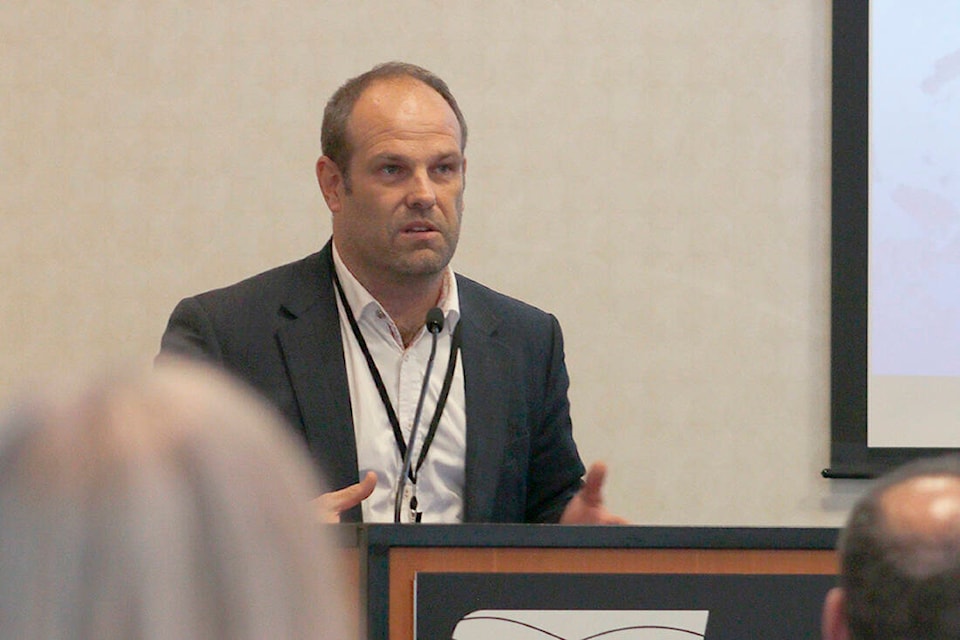Leaders of Vancouver IslandBดฮิชนูอ๘อ๘ึทs aquaculture industry spoke about the potential of B.C.Bดฮิชนูอ๘อ๘ึทs Bดฮิชนูอ๘อ๘ึทblue economyBดฮิชนูอ๘อ๘ึท and the future of sustainable uses of ocean resources and maritime assets at the State of the Island Economic Summit.
On Wednesday, Oct. 25, at NanaimoBดฮิชนูอ๘อ๘ึทs Vancouver Island Conference Centre, a panel of experts from ocean-related industries discussed B.C.Bดฮิชนูอ๘อ๘ึทs ocean economy, which is expected to be a $3-trillion industry worldwide by 2030, according to the U.K. government.
The panel spoke about two specific marine industries on the Island: salmon farming, which is B.C.Bดฮิชนูอ๘อ๘ึทs biggest agricultural export, and seaweed harvesting, an up-and-coming industry that is expected to leverage current assets of other marine sectors to produce revenue during down seasons.
Brian Kingzett, executive director of the B.C. Salmon Farmers Association, said the salmon farming industry is Bดฮิชนูอ๘อ๘ึทprobably the most misunderstood, misrepresented and political in the ocean sector right now,Bดฮิชนูอ๘อ๘ึท after 15 farms werenBดฮิชนูอ๘อ๘ึทt allowed to renew their licences.
READ MORE:
Despite the fallbacks, he said he continues to advocate for the industry and collaborate with multiple companies and organizations to make the industry more sustainable. He also praised ongoing innovation in the sector, mentioning new hybrid-powered vessels and an upcoming AI-powered camera that can identify individual fish by the spots on their side and can detect health issues and parasites on the farmed fish to further protect wild fish.
Kingzett spoke about the importance of collaborating with other organizations and governments to further expand the industry, especially with Scandinavian countries like Norway, which he said has more than 1,000 salmon farms and is one of the leaders in new technological advancements in the industry.
In addition to working with foreign entities, he stressed the importance of working with Indigenous groups on the Island. He mentioned visiting Kitasoo XaiBดฮิชนูอ๘อ๘ึทxais First Nation in the 1980s before salmon farming completely turned around the unemployment rate, and said one in two households are now involved in the sector.
Bดฮิชนูอ๘อ๘ึทThereBดฮิชนูอ๘อ๘ึทs a knowledge that Indigenous communities bring, just from being on the ocean and around the ocean in this sector, and thatBดฮิชนูอ๘อ๘ึทs an important thing to consider in any phase in these development paths we take,Bดฮิชนูอ๘อ๘ึท said Jason Goldsworthy, executive director of the Centre for Ocean Applied Sustainable Technologies.
Mark Smith, CEO of the Pacific Seaweed Association, talked about how his sector Bดฮิชนูอ๘อ๘ึทplays wellBดฮิชนูอ๘อ๘ึท with fish farmers and shellfish harvesters as an Bดฮิชนูอ๘อ๘ึทancillary add-on productBดฮิชนูอ๘อ๘ึท and additional revenue source.
Bดฮิชนูอ๘อ๘ึทWe are the largest coastline globally, [and] just on Vancouver Island alone, studies show over 600 different varieties of seaweed Bดฮิชนูอ๘อ๘ึทฆ three are currently being leveraged as commercial opportunities,Bดฮิชนูอ๘อ๘ึท he said.
Smith said his association believes seaweed could provide up to $1 billion of net new GDP to the provincial economy, not just as a lone export, but in collaboration with other aquaculture industries and Bดฮิชนูอ๘อ๘ึทleveraging assetsBดฮิชนูอ๘อ๘ึท already in use by those industries.
As an example, he mentioned an organization in Maine that helps the sometimes struggling lobster fishing industry by helping fishermen harvest seaweed during the off-season for a Bดฮิชนูอ๘อ๘ึทflatline revenue opportunity.Bดฮิชนูอ๘อ๘ึท
Despite the seemingly bright future of ocean industries, there will be further setbacks like climate change and tighter regulation, the panelists said. Goldsworthy said a challenge for the aquaculture infrastructure is the remoteness of some sites and farms, especially for the electrical grid; however, he also sees it as an opportunity for further innovation.
Kingzett said the north Pacific has more salmon right now than itBดฮิชนูอ๘อ๘ึทs had in centuries because salmon are moving north due to climate change. With AsiaBดฮิชนูอ๘อ๘ึทs growing middle class and increased seafood consumption in North America, wordwide demand by 2050 will require Bดฮิชนูอ๘อ๘ึทanother oceanBดฮิชนูอ๘อ๘ึทs supplyBดฮิชนูอ๘อ๘ึท of seafood, Bดฮิชนูอ๘อ๘ึทso we are now competing with all the rest of the world just even to have access to seafood.Bดฮิชนูอ๘อ๘ึท
READ ALSO:
bailey.seymour@nanaimobulletin.com
Like us on and follow us on




.jpg)